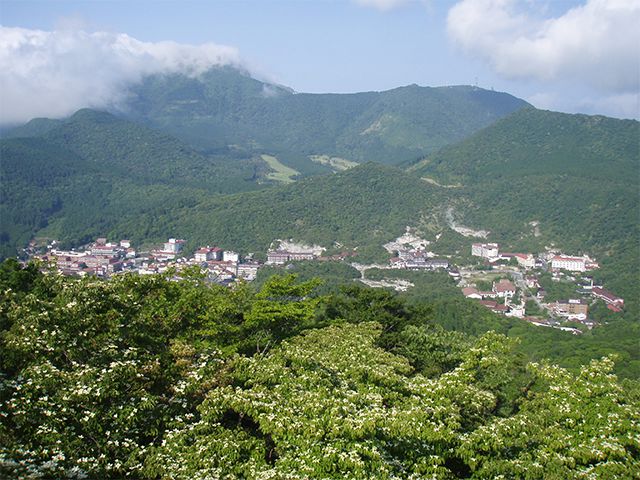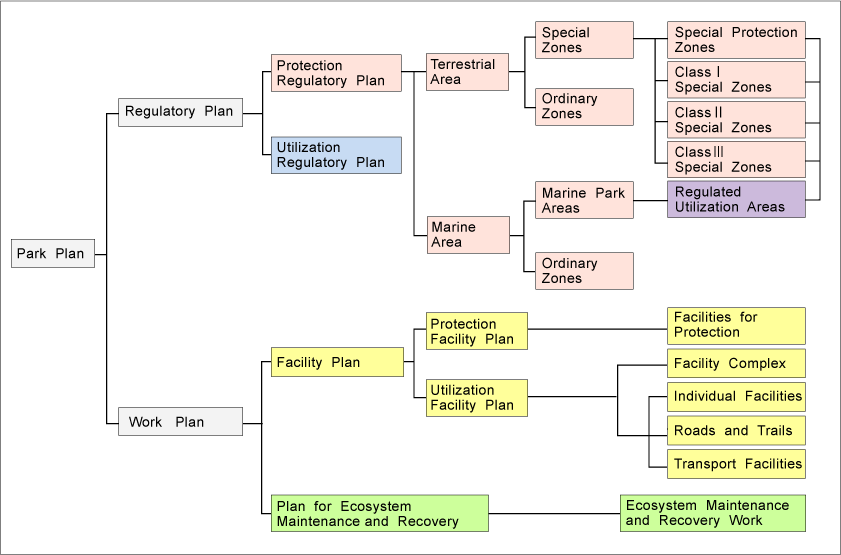- MOE
- National Parks of Japan
- Definition of National Parks
- History and Organization

National parks aim to protect Japan's stunning natural sites and preserve these for future generations so the latter can experience these with the same sense of wonder and joy as we have.
To achieve these objectives, management systems and structures have been put in place.
National Parks '80-year History
Although national parks are currently common in many countries around the world, the Yellowstone National Park in the United States was the first park to be designated as a national park in 1872. In Japan, an “Application to Recognize Nikko as an Imperial Park” was submitted to the National Diet in 1911. Two decades later, the National Park Act was enacted in 1931 to respond to growing calls by citizens. On this basis, Setonaikai, Unzen and Kirishma were designated as the first three national parks on March 16, 1934.

of Mt. Unzen from Mt. Kinugasa

In 1957, the National Parks Act underwent comprehensive revision and the Natural Park Act was enacted, leading to the establishment of the present-day natural parks classification consisting of national parks, quasi-national parks, and prefectural natural parks. Systems and structures were deployed to promote the protection and optimal usage of Japan's wonderful natural landscapes and allow careful management, and these have remained in place until today. Japan has 34 national parks stretching from Hokkaido in the north to Okinawa and the Ogasawara Islands in the south, and they attract a large number of visitors every year.
Japan's National Park System
National parks are subject to the systems and structures, etc., outlined in the Natural Parks Act, which aim to promote protection and optimal usage of natural resources.
Definition of National Park
National parks are designated as such by the Minister of the Environment in accordance with the Natural Parks Act and thus fall directly under the jurisdiction of the government. This serves two purposes: (1) it restricts development projects and other human activities with a view to protecting the exceptional natural landscapes that are characteristic of Japan, and (2) it fosters a joyful experience of nature, including an appreciation of landscapes.
Comparison Table for National, Quasi-National and Prefectural Natural Parks
| Designating Party | Minister of the Environmen |
|---|---|
| Requirements for Designation | Must constitute a landscape that is representative of Japan relative to the places with the same type of landscape as well as constitute a prominent natural landscape that can be introduced to the world with pride. |
| Governing Law | Natural Parks Law [402KB] |
| Party Responsible for Administrative Management | Minister of the Environment |
| Designating Party | Minister of the Environment |
|---|---|
| Requirements for Designation | Must constitute a prominent major natural landscape comparable to the landscape found in Natural Parks. |
| Governing Law | Natural Parks Law [402KB] |
| Party Responsible for Administrative Management | Prefectural governments |
| Designating Party | Prefectural governors |
|---|---|
| Requirements for Designation | Must constitute a prominent natural landscape that is representative of landscapes at a prefectural level. |
| Governing Law | Prefectural ordinances |
| Party Responsible for Administrative Management | Prefectural governments |
Park Plan
To ensure adequate protection and usage of national parks, Park Plans are formulated for each national park. The Park Plan determines the scope of regulation that governs national park grounds (land zone classification), and the arrangement of facilities, etc. The Park Plan is divided into a Regulatory Plan and a Project Plan.
(1) Regulatory Plan
Amid growth in disorderly land development and usage, the Regulatory Plans aims to protect the natural landscape by regulating activities conducted on park grounds. The type and scope of activities subject to regulation are determined in accordance with the land zone classification, which distinguishes six different zones on the basis of natural environment and usage conditions: Special Protection Zones, Class I-III Special Zones, Marine Park Zones and Ordinary Zones. In addition, Regulated Utilization Areas are established for areas where the natural environment is at risk of damage due to overuse or where appropriate and harmonious use may lost. Regulated Utilization Areas aim to support favorable conditions for natural landscapes and proper usage by restricting access to certain periods and limiting the number of people that can enter the area.
(2) Business Plan
The Project Plan outlines various measures and facilities required to protect park landscape or landscape elements, ensure visitor safety, promote appropriate usage, and aim to maintain and restore relevant ecosystems. It may take the form of a Facilities Plan or an Ecosystem Maintenance and Restoration Project Plan.
In addition to national parks, Park Plans are similarly formulated for quasi-national parks and prefectural natural parks, but prefectural natural parks do not have Special Protection Zones subject to a Protection Regulation Plan, nor do they have a Marine Park Zone system.
The Facilities Plan outlines the facilities necessary for appropriate use of parks as well as those required for the restoration of devastated natural environments and prevention of danger. Based on each plan, facilities are established as park projects. Public project facilities such as roads, restrooms, and vegetation restoration facilities are generally established by the government or relevant municipalities, while commercial project facilities such as hotels and the like are established by private organizations.
The Ecosystem Maintenance and Restoration Project Plan aims to maintain and restore exceptional natural landscapes. When areas are deemed at risk of feeding damage from deer, crown-of-thorns starfish (Acanthaster planci) or other animals, or in situations where the ecosystem is prone to damage (or actually incurring damage) as a result of invasive species overtaking native animals or plants, several preventative or responsive initiatives are conducted to capture the offending animals, remove the invasive species and protect natural vegetation and the coral communities.
Diagram of Park Plans
(Click on a term in this diagram to jump to the explanation provided for that term.)
 Regulation Plan
Protection Regulatory Plan
Special Protection Zones
Class 1 Special Zones
Class 2 Special Zones
Class 3 Special Zones
Marine Park Areas
Ordinary Zones
Regulated Utilization Areas
Utilization Regulatory Plans
Business Plan
Protection Facility Plan
Utilization Facility Plan
Facility Complex
Individual Facilities
Roads and Trails
Transport Facilities
Ecosystem Maintenance and Restoration Plan
Regulation Plan
Protection Regulatory Plan
Special Protection Zones
Class 1 Special Zones
Class 2 Special Zones
Class 3 Special Zones
Marine Park Areas
Ordinary Zones
Regulated Utilization Areas
Utilization Regulatory Plans
Business Plan
Protection Facility Plan
Utilization Facility Plan
Facility Complex
Individual Facilities
Roads and Trails
Transport Facilities
Ecosystem Maintenance and Restoration Plan
Explanation of Terminology Used for Park Plans
| Term | Explanation | Examples, Interpretations, Other Comments |
|---|---|---|
| Protection Regulatory Plan | Protection Regulatory Plans are plans formulated to promote protection from development and excessive use by restricting specified actions inside parks; zones corresponding to regulations of varying compulsive | |
| Special Protection Zones | Special Protection Zones are zones corresponding to particularly exceptional landscape areas inside parks that have maintained their original state and are subject to the strictest restrictions on permissible actions. | Restricted actions are subject to an authorization system. |
| Class 1 Special Zones | Class 1 Special Zones are areas that have landscape comparable to Special Protection Zones and that correspond to the greatest need to maintain scenic beauty among all categories of Special Zones, that they are areas for which the present landscape requires as much protection as possible. | Restricted actions are subject to an authorization system. |
| Class 2 Special Zones | Class 2 Special Zones are areas for which efforts to make adjustments and coordinate with farming, forestry, or fishing activities are required. | Restricted actions are subject to an authorization system. |
| Class 3 Special Zones | Class 3 Special Zones are areas that have a low need to maintain scenic beauty relative to all other categories of Special Zones and that have less potential impact on maintain scenic beauty in principle with respect to normal farming, forestry, or fishery. | Restricted actions are subject to an authorization system. |
| Marine Park Areas | Marine Park Areas are zones that have to maintain topography of tidal flat and shore reef, etc., and scenic beauty over the sea characterized by wildlife such as seabirds, in addition to exceptional landscape in the sea characterized by tropical fish coral, seaweed, plants and animal life similar to them. | Restricted actions are subject to an authorization system. |
| Ordinary Zones | Ordinary Zones are areas that do not come under the classification of Special Zones or Marine Park Zones; efforts to protect the landscape are made in these areas. They are referred to as buffer zones between Special Zones or Marine Park Zones and non-park zones. | Restricted actions are subject to a notification system. |
| Term | Explanation | Examples, Interpretations, Other Comments |
|---|---|---|
| Regulated Utilization Areas | Regulated Utilization Areas are zones for which the objective is to protect the natural ecosystem and promote long-term use by adjusting the number of users and other variables in areas with particularly exceptional scenic landscapes where an increase in the number of users is having a negative impact. | User access requires authorization. |
| Term | Explanation | Examples, Interpretations, Other Comments |
|---|---|---|
| Utilization Regulatory Plans | Utilization Regulatory Plans are plans to cope with expanded use in particularly exceptional landscape areas to promote appropriate use and protect the natural environment in the vicinity. These plans set forth matters for which adjustments, limits, or bans on use periods, methods, and other relevant details are required. | Optimizing automobile use (Regulation of private cars); Regulated Utilization Areas. |
| Term | Explanation | Examples, Interpretations, Other Comments |
|---|---|---|
| Protection Facility Plan | Protection Facility Plans are plans for facilities that are required to restore degraded natural environments and ensure safety precautions (protection facilities). | Vegetation restoration facilities, animal-breeding facilities, erosion-control facilities, fire-prevention facilities, and more. |
| Utilization Facility Plan | Utilization Facility Plans consist of plans for Facility Complex that serve as a hub of park use and management and plans for facilities required for the appropriate use of parks. | Utilization Facility is designed as not to add any negative influence to natural landscape. |
| Facility Complex | Facility Complexes are areas where facilities for the use and management of parks are to be developed in an integrated manner. | |
| Individual Facilities | Includes picnic sites, hotel & lodge, rest area, campsites. | |
| Roads and Trails | Includes vehicular roads, bicycle paths, and walking trails. | |
| Transport Facilities | Includes railroads, aerial cableways, lifts, and watercraft. |
| Term | Explanation | Examples, Interpretations, Other Comments |
|---|---|---|
| Ecosystem Maintenance and Recovery Work | The purpose of this plan is to conduct preventative or responsive initiatives to sustain and restore natural ecosystems. Initiatives may include capturing harmful animals such as deer and crown-of-thorns starfish, removing invasive species, and protecting natural vegetation and coral communities. |


